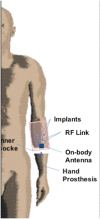Characterization of In-Body to On-Body Wireless Radio Frequency Link for Upper Limb Prostheses
- PMID: 27764182
- PMCID: PMC5072669
- DOI: 10.1371/journal.pone.0164987
Characterization of In-Body to On-Body Wireless Radio Frequency Link for Upper Limb Prostheses
Abstract
Wireless implanted devices can be used to interface patients with disabilities with the aim of restoring impaired motor functions. Implanted devices that record and transmit electromyographic (EMG) signals have been applied for the control of active prostheses. This simulation study investigates the propagation losses and the absorption rate of a wireless radio frequency link for in-to-on body communication in the medical implant communication service (MICS) frequency band to control myoelectric upper limb prostheses. The implanted antenna is selected and a suitable external antenna is designed. The characterization of both antennas is done by numerical simulations. A heterogeneous 3D body model and a 3D electromagnetic solver have been used to model the path loss and to characterize the specific absorption rate (SAR). The path loss parameters were extracted and the SAR was characterized, verifying the compliance with the guideline limits. The path loss model has been also used for a preliminary link budget analysis to determine the feasibility of such system compliant with the IEEE 802.15.6 standard. The resulting link margin of 11 dB confirms the feasibility of the system proposed.
Conflict of interest statement
The authors have declared that no competing interests exist.
Figures












References
-
- Movassaghi S, Member S, Abolhasan M, Member S. Wireless Body Area Networks : A Survey. IEEE Commun Surv Tutorials. 2014;16(3):1658–86.
-
- Bazaka K, Jacob M V. Implantable Devices: Issues and Challenges. Electronics. 2012;2(1):1–34.
-
- Hall PS and Hao Y. Antennas and Propagation for Body-Centric Wireless Communications. Boston, MA: Artech House; 2006.
MeSH terms
LinkOut - more resources
Full Text Sources
Other Literature Sources
Medical
Miscellaneous

